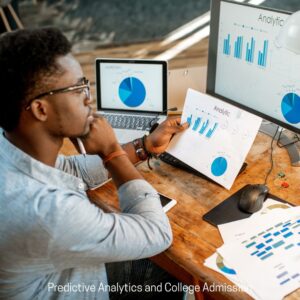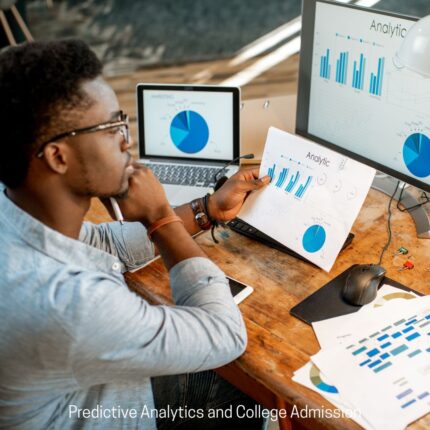Predictive Analytics’ Impact on College Admission: What You Should Know
Last Updated on June 5, 2025 by Jill Schwitzgebel
It’s no secret that the college admissions experience has changed considerably in the last decade. And in many cases, it bears no resemblance to the process most of us went through when applying to college. Colleges can now combine data and technology to come up with sophisticated algorithms to use in the admission process. Yes, all the traditional factors like GPAs, test scores and essays absolutely still matter. But, data science has become an important tool in combining all information about applicants once their applications get to a college admission department. So, let’s talk about the impact of predictive analytics on college admission these days.

Predictive Analytics
So, before going any further, what exactly ARE “predictive analytics?” According to IBM, predictive analytics “is a branch of advanced analytics that makes predictions about future outcomes using historical data combined with statistical modeling, data mining techniques and machine learning.” So, in the context of college admissions, this means analyzing datasets and using patterns to predict which students are most likely to succeed academically, socially, and financially at an institution. Additionally, and just as importantly in some cases, they’re using analytics to predict who is likely to attend if admitted.
An admissions department can use predictive analytics to evaluate whether an applicant’s high school performance, extracurricular activities, and overall background indicate that they are a good fit for particular academic program or whether they are likely to contribute to the campus community. But colleges begin using analytics before students even apply.
Ways that Colleges are Using Predictive Analytics
Personalizing the Application Experience
Instead of sending blanket emails or generic marketing materials, colleges (like any other “retailer”) can personalize their outreach based on the likelihood of an applicant being a good fit for the school. For instance, if a predictive model identifies a student with a strong interest in science and research, a university might highlight its STEM programs and research opportunities in their communications to that applicant.
Holistic Application Evaluation
Colleges have long relied on holistic evaluation—looking at the whole student, not just their test scores and grades. Predictive analytics can more easily analyze past admissions data to see which student characteristics correlate with success in their specific programs. This could include factors such as high school GPA, AP course enrollment, leadership roles in extracurriculars, or even socioeconomic background. Thanks to predictive analytics, institutions are now able to more easily combine a wide variety of data points (academic performance, essays, recommendation letters, and even social media activity) to make decisions.
Financial Aid and Scholarship Offers
A predictive model might analyze factors including financial information, GPA, test scores, and the applicant’s choice of major to determine the likelihood of the student needing a financial aid. It can also help predict whether a student is likely to drop out due to financial stress or academic challenges. Recently, much has been written about how colleges are even using predictive analytics to determine how much financial aid (often in the form of merit scholarships) they need to offer to entice a student to attend.
What Data Do Colleges Use?
High School Performance Data
This has not changed much with analytics, though it’s safe to say that the rating process is easier for colleges now. Colleges will look at GPA, including trends in academic performance (e.g., improvement in grades over time) and also course rigor (e.g., honors, AP, IB classes). When ACT or SAT scores are submitted and considered, those will also be factored in.
Extracurricular Data
The types and depth of extracurricular activities can provide insight into a student’s character, leadership abilities, and commitment. Predictive models are able to use historical data about students admitted in the past to assess the significance of these activities. The models can even help forecast whether students are likely to participate in similar activities when they get to college.
Behavioral Data
To me, this is where predictive analytics has made the biggest impact. This category of data includes information about how potential and actual applicants interact with the college’s website. It can include how often they visit specific pages (e.g., financial aid or academics or campus life), as well as their engagement on the college’s social media platforms. Behavioral data helps institutions understand what aspects of the school attract what specific type of students and how interested they are in attending. And, it helps the college to understand whether or not a student is likely to attend if they make an offer of admission.
This information can help the college to really tailor their website and their outreach to help them attract the student population they want. For instance, St Mary’s College in MD discovered that if a student visits, they are more likely to enroll. So, they put great effort into making sure that potential students get personal tours when they visit, to increase the likelihood of enrollment.
Probably most importantly, using predictive analytics allows colleges to combine ALL of these variables to try to create a fuller picture of an applicant. The college may score applicants on things like resilience, motivation, or community involvement.
Implications
Obviously, all of this has implications for potential college applicants. In some ways, little has changed in how students should approach applying – admissions are still holistic. Applicants still need to strive to have a strong academic transcript, which includes good grades in a curriculum that challenges them. Extracurriculars, leadership and personal character all certainly still matter. And, I think there is an argument to be made that predictive analytics only helps prospective students – it means that colleges can really target the kinds of students they would most like to have on campus. As much as we talk about students finding colleges that are the right fit, now it means that colleges are better able to attract students that are the right fit for them too.
Now, students can leverage the ways colleges are using analytics to give them an edge in admissions though. Applicants should engage with websites of all colleges that are of interest, participate in virtual events that are offered, and even follow their official accounts on social media. Colleges will be looking at those kinds of data signals. And, this is not a change, but it may be even more important now – students need to be very mindful about their own online presence on social media and the internet.
Applicants may not fully understand how their data is being used or which factors are influencing their admission chances. It is my hope that admissions offices will communicate clearly about their data use to help all of us maintain trust in the admissions process. But from experience, there will always be a bit of mystery about admissions and we shouldn’t expect that colleges are ever going to disclose the specifics of the algorithms that they’re using.










One Comment